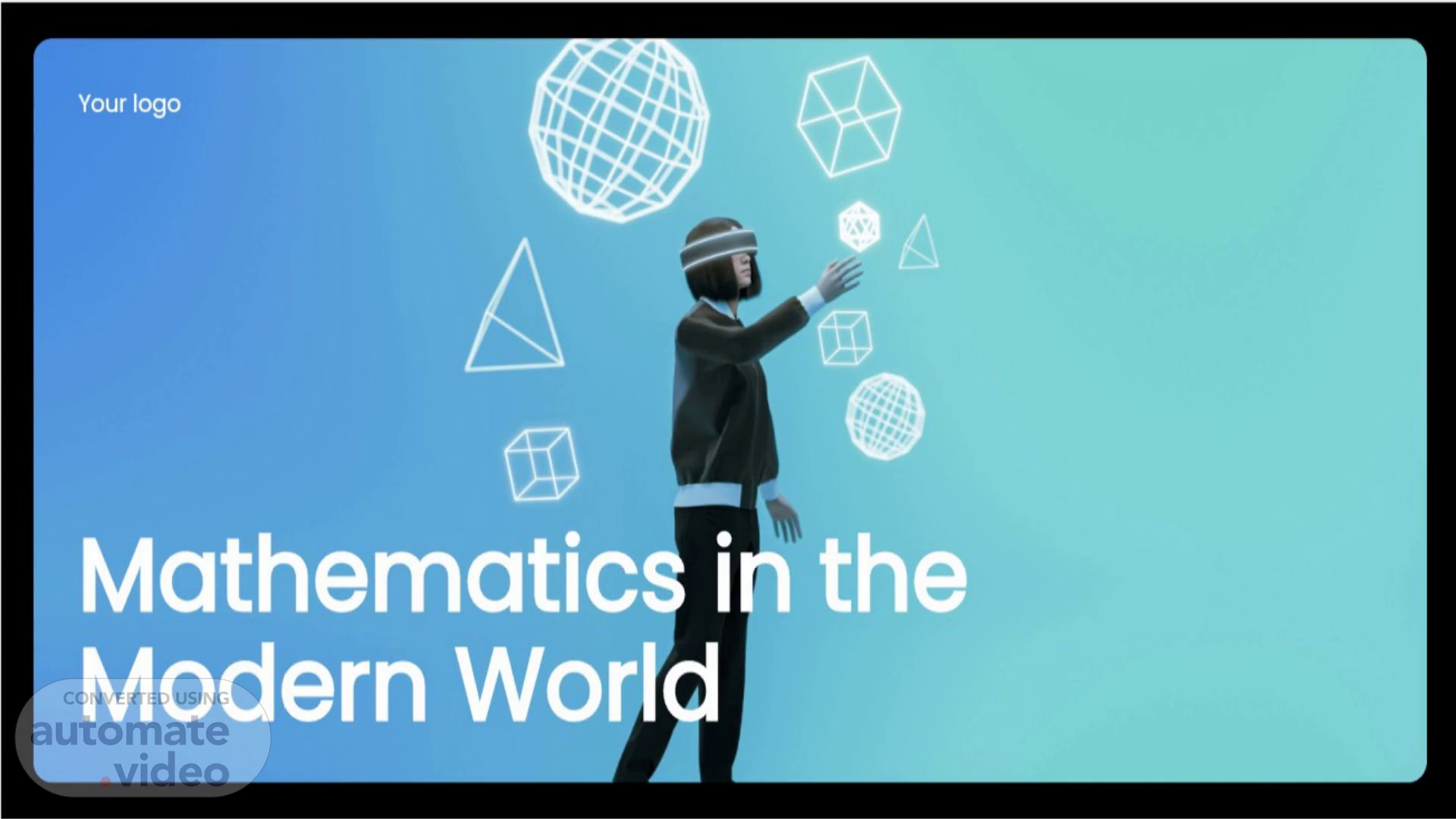Scene 1 (0s)
Your logo Mathematic i the Modern Wor19.
Scene 2 (6s)
Your logo. Course Objectives. At the end of the semester, the students should be able to: Discuss the language, symbols and conventions of mathematics Identify patterns in nature and regularities in the world Argue about the nature of mathematics, what it is, how it is expressed, represented and used. Explain the nature of mathematics as a language Write clear and logical proofs Use different types of reasoning to justify statements and arguments made about mathematics and mathematical concepts..
Scene 3 (29s)
Your logo. description. Module #1 Topic: THE NATURE OF MATHEMATICS MATHEMATICS is: the study of pattern and structure. a useful way to think about nature and our world. a tool to quantify, organize and control our world, predict phenomena and make life easier for us. MATHEMATICS is in many patterns and occurrences that exists in nature, in our world, and in our life.
Scene 4 (48s)
Contents 01 02 03 04 05 06 07 The Evolution of Mathematics Mathematics in Technology Mathernatics in Science Mathematics in Economics and Finance Mathematics in Everyday Life Challenges and Future Directions Conclusion.
Scene 5 (1m 1s)
Your logo. Chapter 1 Nature of Mathematics.
Scene 6 (1m 8s)
Modern Developments 01 03 The Rise of Calculus and Algebra Calculus and algebra revolutionized mathematics by introducing systematic methods for solving complex problems, enabling advancements in science, engineering, and technology throughout the modern era. 02 The Impact of Computers on Mathematics Computers revolutionized mathematics by enabling complex calculations, visualizations, and simulations, accelerating discoveries, enhancing problem-solving, and fostering new fields like computational mathematics and algorithm theory. Contemporary Mathematical Theories Contemporary mathematical theories, such as chaos theory, topology, and category theory, have expanded understanding in complex systems, abstract structures, and interconnections across disciplines, driving innovation in technology and science..
Scene 7 (1m 39s)
Your logo. Chapter 2 Mathematical Language.
Scene 8 (1m 45s)
Applications in Engineering Structural Analysis Structural analysis uses mathematical models and algorithms to predict stress, strain, and deformation in engineering structures, ensuring safety and efficiency in design and construction processes. Signal Processing Signal processing uses mathematical techniques like Fourier transforms to analyze, modify, and synthesize signals, enabling advancements in communications, audio, and image engineering technologies. Robotics and Automation Mathematics enables precise modeling and control in robotics and automation, optimizing algorithms for movement, sensor integration, and decision-making to enhance efficiency and accuracy in engineering applications..
Scene 9 (2m 10s)
Your logo. Chapter 3 Problem Solving.
Scene 10 (2m 16s)
Economic Modeling Predictive Analytics Predictive analytics uses mathematical models and statistical techniques to forecast economic trends, optimize financial decisions, and assess risks, enhancing accuracy in economic modeling and strategic planning. Game Theory Applications Game theory rnodels strategic interactions among rational agents in economics, optimizing decision-making in competitive markets, auctions, and negotiations, enhancing predictions of outcomes and behaviors. 02 01 Optimization Techniques Optimization techniques in economic modeling help identify the best allocation of resources, maximizing profits or minimizing costs, crucial for decision- making under constraints in finance and economics. 03.
Scene 11 (2m 42s)
Your logo. Chapter 4 Statistics.
Scene 12 (2m 48s)
Financial Mathematics Risk Assessment and Management Mathematics quantifies financial risks using models like Value at Risk and Monte Carlo simulations, enabling effective risk assessment and management in investrnent and portfolio optimization. Stock Market Analysis Mathematics in stock market analysis uses statistical models, probability, and calculus to predict price movements, assess risks, and optimize investment strategies for better financial decision-making. Derivatives and Pricing Models Derivatives enable risk management through contracts based on underlying assets. Pricing models, like Black-Scholes, use mathematical formulas to determine fair values, ensuring efficient financial markets..
Scene 13 (3m 16s)
Your logo. Chapter 5 Logic.
Scene 14 (3m 22s)
Practical Uses of Mathematics Personal Finance Management Budgeting, saving, and investing rely on basic mathematical skills such as addition, subtraction, percentages, and interest calculations to manage personal finances effectively and plan for future expenses. Statistics in Decision Making Statistics help analyze data trends, improving decision accuracy in business, healthcare, and daily life by predicting outcomes and optimizing resources efficiently. Mathematics in Cooking and Shopping Mathematics helps measure ingredients accurately in cooking and calculate discounts, budgets, and total costs efficiently while shopping, ensuring both precision and savings in daily life..
Scene 15 (3m 52s)
Your logo. Chapter 6 The Mathematics of Graphs.
Scene 16 (3m 59s)
Practical Uses of Mathematics Personal Finance Management Budgeting, saving, and investing rely on basic mathematical skills such as addition, subtraction, percentages, and interest calculations to manage personal finances effectively and plan for future expenses. Statistics in Decision Making Statistics help analyze data trends, improving decision accuracy in business, healthcare, and daily life by predicting outcomes and optimizing resources efficiently. Mathematics in Cooking and Shopping Mathematics helps measure ingredients accurately in cooking and calculate discounts, budgets, and total costs efficiently while shopping, ensuring both precision and savings in daily life..
Scene 17 (4m 26s)
Your logo. Chapter 7 Mathematical Systems.
Scene 18 (4m 33s)
Mathematics in Computing Algorithms and Data Structures Algorithms optimize problem-solving efficiency, while data structures organize and manage data effectively. Together, they form the foundation of computing, enabling faster processing and improved software performance. Cryptography and Security Cryptography uses mathematical algorithms to secure data, ensuring privacy and authentication in digital communication, protecting information from unauthorized access and cyber threats. Artificial Intelligence and Machine Leaming Artificial Intelligence and Machine Learning rely on mathematical models like linear algebra, calculus, and statistics to process data, recognize patterns, and improve decision-making algorithms. 08 J.
